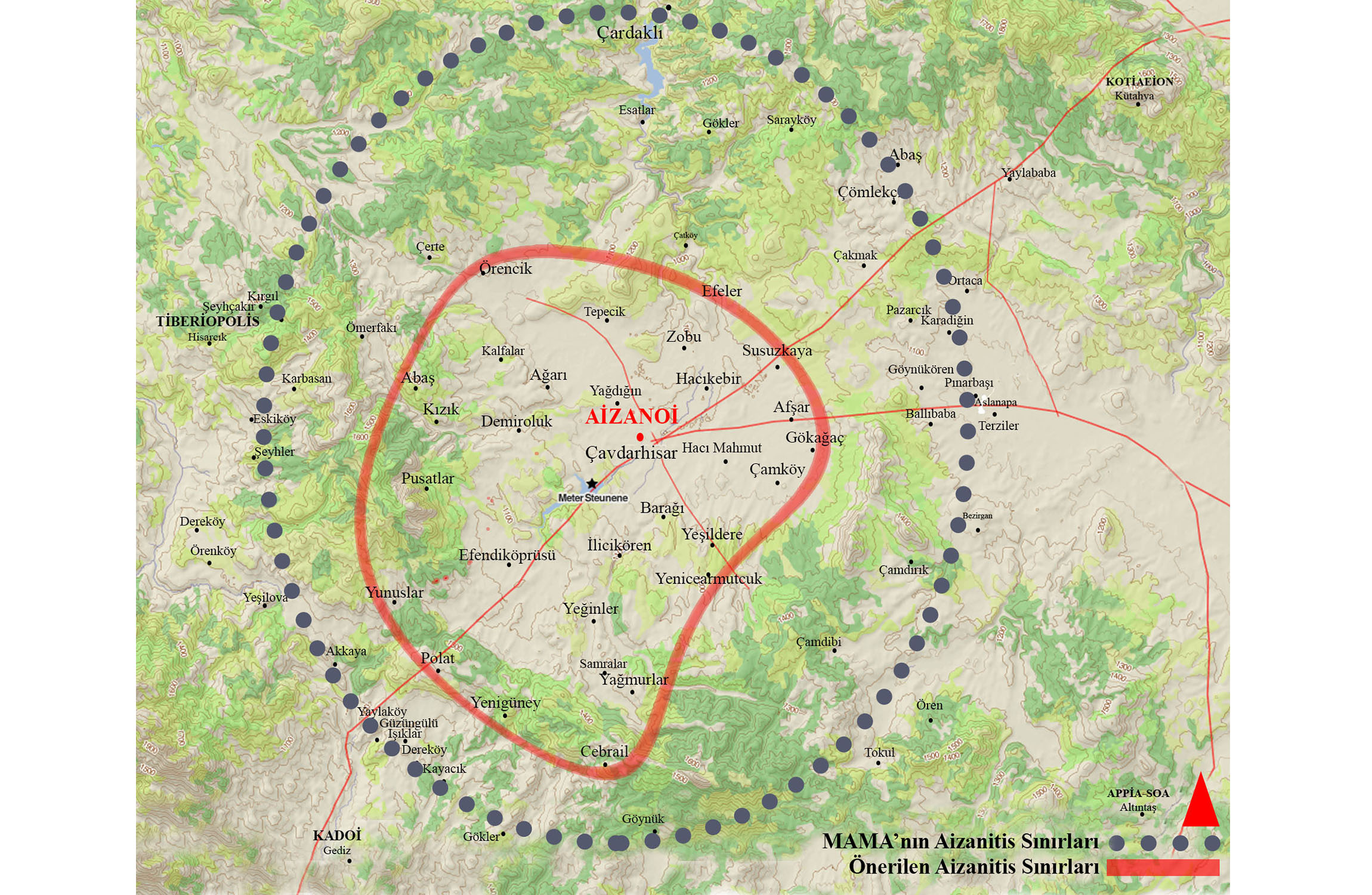A Suggestion on Aizanitis Region Borders
Zerrin ERDİNÇ
Abstract
In the studies carried out in and around the ancient city of Aizanoi in Çavdarhisar district of Kütahya province, important data about the geography of the region and the territory of the city were obtained. Aizanoi and its surroundings were referred to as the “Aizanitis Area” in the Roman Period, and the people living here are called “Aizanitians”. This name is also fixed by the epigraphic data found in the city and the works of ancient authors that have survived to the present day. Among the ancient neighbors of the region, which is generally localized to the Örencik Plain, are Kotiaeion (Kütahya) in the northeast, Appia (Pınarcık) in the southeast, Kadoi (Gediz) in the southwest and Tiberiopolis (Hisarcık) in the northwest. Although the studies conducted by previous researchers in the region in question contain important data on the borders of the region, they do not contain enough detailed information on this subject. The aim of this study is to determine the geographical borders of the region known as Aizanitis and to determine the territory of the ancient city of Aizanoi. In this context, first of all, the surrounding of the city of Aizanoi and the village settlements located on the borders of Çavdarhisar district were visited, the geography of the region was examined and the geographical signs found in important points such as rivers, mountains and plains were followed. In addition, the typology of the milestones providing epigraphic data on roads and settlements and the tomb steles presenting important and distinctive archaeological data in the region were also evaluated. In places where the boundaries of the region are controversial, the archaeological data and the topography of the region were taken into consideration in order to reach the closest results. In this study, for the first time, a border proposal was made for the Aizanitis Region by giving the names of the modern village settlements within the borders of Çavdarhisar district today.
Antik Kaynaklar
Strab.: Strabon, Geographica XII-XIII-XIV. Kullanılan Metin ve Çeviri: Strabon, Antik Anadolu Coğrafyası (Geographika: XII-XIII-XIV). (Çev. A. Pekman) İstanbul 1992.
Modern Kaynaklar
Anderson, J. G. C. (1898). Exploration in Asia Minor during 1898: First Report. BSA, 4, 49-78. https://doi.org/10.1017/S0068245400001015
Burrell, B. (2003). Neokoroi: Greek Cities and Roman Emperors. Brill.
Darkot, B. ve Tuncel, M. (1988). Ege Bölgesi Coğrafyası. İstanbul Üniversitesi Yayınları.
Drew-Bear, T. ve Eck, W. (1976). Kaiser-, Militär- und Steinbruchinschriften aus Phrygien. Chiron, 6, 289-318.
Dürr, J. (1881). Die Reisen des Kaisers Hadrian. Carl Gerold’s Sohn.
Fellows, C. (1839). A Journal Written During an Excursion in Asia Minor: 1838. John Murray.
French, D. (1993). 1991 Yılı Roma Yolları, Miltaşları ve Yazıtları Araştırması. Araştırma Sonuçları Toplantısı, 10, 199-206.
French, D. (2016). Roman Roads and Milestones of Asia Minor Vol. 4: The Roads, Fasc. 4.1: Notes on the Itineraria. British Institute of Archaeology.
Hamilton, W. J. (1842). Researches in Asia Minor, Pontus, and Armenia: With Some Account of their Antiquities and Geology I. Murray.
IGR IV: Inscriptiones graecae ad res romanas pertinentes IV.
İznik, E. (2006). Roma İmparatorluk Döneminde Frigya Epiktetos Merkezlerinde (Dorlaeyon, Nacolea, Midaeum, Cotiaeum, Aezanai) Sosyopolitik, Sosyoekonomik ve Sosyokültürel Yapı [Yayımlanmamış Doktora Tezi]. Anadolu Üniversitesi.
Jes, K. (2001). Ein hochhellenistischer Statuettenkopf aus Aizanoi. AA, 2, 295-301.
Le Bas, P. ve Waddington, W. H. (1847). Voyage archéologique en Grèce et en Asie Mineure: Fait par ordre du gouvernement français pendant les années 1843 et 1844. Firmin Didot frères.
Lochman, T. (2003). Studien zu kaiserzeitlichen Grab- und Votivreliefs aus Phrygien. Skulpturhalle Basel.
Lochner, I. (2010). Der Siedlungshügel von Aizanoi in vorrömischer Zeit. K. Rheidt (Ed.), Aizanoi und Anatolien (ss. 23-37). Philipp von Zabern.
Magie, D. (1950). Roman Rule in Asia Minor I-II. Princeton University Press.
MAMA IX: Levick, B., Mitchell, S., Potter, J. ve Waelkens, M. (1988). Monumenta Asiae Minoris Antiqua, IX: Monuments From the Aezanitis (JRS Monographs no. 4). Society for the Promotion of Roman Studies.
MAMA X: Levick, B., Mitchell, S., Potter, J. ve Waelkens, M. (1993). Monumenta Asiae Minoris Antiqua, vol. X: Monuments from the Upper Tembris Valley, Cotiaeum, Cadi, Synaus, Ancyra, and Tiberiopolis (JRS Monographs no. 7). Society for the Promotion of Roman Studies.
Munro, J. A. R. ve Anthony, H. M. (1897). Explorations in Mysia. The Geographical Journal, 9(2), 150-169. https://doi.org/10.2307/1773503
Munro, J. A. R. (1897). Inscriptions from Mysia. JHS, 17, 268-293. https://doi.org/10.2307/623830
Naumann, R. ve Naumann, F. (1973). Der Rundbau in Aezani. IstMitt-BH, 10. Verlag Ernst Wasmuth.
Naumann, R. (1979). Der Zeustempel zu Aizanoi. Walter de Gruyter.
Oy, H. (2018). İçbatı Anadolu’da Kutsal Bir Dağ: Murat Dağı (Dindymos). Selçuk Üniversitesi Edebiyat Fakültesi Dergisi, 40, 283-296. https://doi.org/10.21497/sefad.515373
Ramsay, W. M. (1890). The Historical Geography of Asia Minor. John Murray.
Ramsay, W. M. (1975). The Cities and Bishoprics of Phrygia, I-II. Arno Press.
Rheidt, K. (2008). Aizanoi in hellenistischer Zeit. E. Schwertheim ve E. Winter (Ed.), Neue Funde und Forschungen in Phrygien (ss. 107-121). Asia Minor Studien, 61. Habelt.
Rheidt, K. (2009). Pile Foundation in the Anatolian Mountains – Wrong Technique at the Wrong Place?. K.-E. Kurrer, W. Lorenz ve V. Wetzk (Eds.), Proceedings of the Third International Congress on Construction History, Vol. 3. Brandenburg University of Technology Cottbus, Germany, 20th-24th May 2009 (ss. 1219-1226). Brandenburg University of Technology.
Romeo, I. (2002). The Panhellenion and Ethnic Identity in Hadrianic Greece. CP, 97(1), 21-40. https://doi.org/10.1086/449565
Şahin, S. (1986). Phrygia Epiktetos. Araştırma Sonuçları Toplantısı 4, 265-268.
Tabbernee, W. (1997). Montanist Inscriptions and Testimonia: Epigraphic Sources Illustrating the History of Montanism. Mercer University Press.
Texier, C. (2002). Küçük Asya. Coğrafyası, Tarihi ve Arkeolojisi, II (Çev. A. Suat). Enformasyon ve Dokümantasyon Hizmetleri Vakfı.
Tuğrul, L. (1964). Tavşanlı ve Civarından Buluntular. İstanbul Arkeoloji Müzeleri Yıllığı 11-12, 162-165.
Waelkens, M. (1986). Die kleinasiatischen Türsteine: Typologische und epigraphische Untersuchungen der kleinasiatischen Grabreliefs mit Scheintür. Philipp von Zabern.
Wörrle, M. (1992). Neue Inschriftenfunde aus Aizanoi I. Chiron, 22, 337-376.
Erdinç, Z. (2021). Aizanitis Bölgesi Sınırlarına İlişkin Bir Öneri. Arkhaia Anatolika, 4, 163-173. https://doi.org/10.32949/Arkhaia.2021.31



